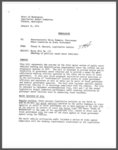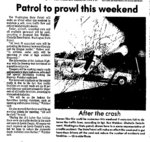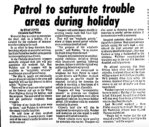




Several pieces I’ve written on the Lewis County Sheriff’s Office, their vehicle graphics and unmarked vehicle usage over the past few months all have a common thread, relating directly back to a single state statute — RCW 46.08.065 — which outlines requirements for publicly owned vehicles.
There had been laws on the state books regarding state vehicle marking requirements since at least 1937. But according to two memos from Legislative Auditor Thomas R. Hazzard, dated Jan. 31 and Feb. 4, 1975, a state performance audit (dated July 19, 1974) discovered that “the requirements of RCW 46.08.065 were not (“not” was underlined in the memo for effect) being followed by state agencies.”
House Bill 172, Hazzard noted, was created to “provide better public visibility of government owned vehicles,” adding that the bill also included specific penalties to “encourage compliance with the statute.”
In this same memo, Hazzard makes a key statement: “A vehicle marking exemption for vehicles used by sheriffs, local police and local peace officers is continued but is limited to vehicles used for undercover or confidential investigative purposes.”
Outside of that, all public vehicles are required to be conspicuously marked.
The section Hazzard is referring to is section one of RCW 46.08.065, which states that state vehicle marking requirements “shall not apply to vehicles of a sheriff’s office, local police department, or any vehicles used by local peace officers under public authority for special undercover or confidential investigative purposes.”
Some have argued that the placement of commas and other things means that local police and sheriff’s deputies are exempted entirely from state marking requirements — but the legislative documents from 1975 illustrate the legislative intent very clearly.
In an April 23, 1975, memo, Hazzard notes that EHB 172 was given a “do pass” recommendation from the Senate State Government Committee, and mentions: “As you recall, this bill, as recommended by the Legislative Budget Committee, had three major features: (1) strengthening the long-standing legislative policy (since 1937) calling for the conspicuous marking of publicly-owned vehicles …”
A legislative digest in the 1975 documents states that “vehicles used by law enforcement authorities for prescribed undercover or special investigative purposes” could be exempted.
The bill analysis from April 16 details the “conditions under which the requirement for identification may be waived as being confidential or undercover investigative purposes.”
Are you sensing a theme here? “Limited to?” “Conspicuous marking?” “Prescribed?”
I harp on this a little bit here because I think it’s really key. This legislation was written to crack down and limit the use of unmarked vehicles to specific purposes.
Confidential investigation, as stated in the statute, is fairly obvious — a criminal investigation or the like.
But what does “special” investigation refer to? To be fair, it is ambiguous.
Around the time this bill was proposed, and in the years leading up to its proposal, I found numerous news archives from across the state in 1960s and 1970s regarding climbing rates of “autocide” — vehicle accident fatalities — on state highways and interstates.
In response to this, the Washington State Patrol began utilizing emphasis patrols in our area in the 1970s, as evidenced by Chronicle archives.
Emphasis patrols, from their inception in our state, weren’t designed just to arrest people — they were designed to deter intoxicated driving before someone ever actually got in a car. Emphasis patrols have a clear educational and informational component. This is why you see news articles, billboards and hear radio ads that inform citizens of upcoming emphasis patrols — quite literally to deter a specific, criminal act from happening in the first place using a scheduled, public campaign.
It seems likely that the legislative language of “special investigations” was actually referring to these types of tools that WSP was beginning to use in the 1970s — emphasis patrols, radar, etc. Prescribed, planned, scheduled use of unmarked vehicles for a clear purpose.
In news coverage archives, local police and counties were invited by WSP to participate in these emphasis patrols — another reason I believe that the Legislature provided the “special investigation” language, specifically for local sheriffs and police officers.
When you consider the contextual timeline of the news headlines, coupled with the legislative documents that led to the passing of 1975’s HB 172, the established intent is clear: Use of unmarked vehicles was to be “limited” for specific “prescribed” law enforcement purposes.
The “Analysis as Enacted” section of HB 172 tells us that “uniform marking standards should be applied to all cars owned by the State and units of local government,” and Appendix One of the bill states that marking requirements are “extended to vehicles controlled by local governments.”
It’s very clear the Legislature was setting a statewide standard to be followed. Yet agencies today continue to round the corners of the statute.
So, if the Legislature was “strengthening” the statute requiring the “conspicuous marking of publicly-owned vehicles” — the same statute that requires contrasted lettering on public vehicles — I think this is yet another indication that LCSO’s black-on-dark-gray vehicle graphics are not in alignment with the spirit of the law.
Statutes even specify minimum letter size and require lettering to be in contrasting color to the vehicle, unless the vehicle qualifies for a specific exemption to be unmarked.
The exemptions are specific and narrow, by legislative design. LCSO is pushing the limits of the statute, at the very least.
The first local challenge to an LCSO-issued ticket, written by a deputy driving a quasi-marked county law enforcement vehicle with “stealth” or “ghost” style black-on-dark-gray graphics, is scheduled to hit local courts this month.
It likely won’t be the last challenge, either.
•••
Brittany Voie is The Chronicle’s senior media developer. She welcomes correspondence from the community by email at bvoie@chronline.com.